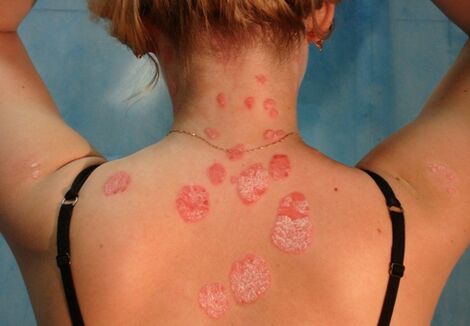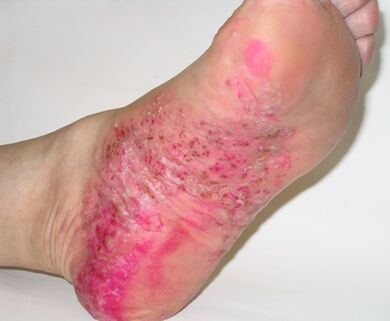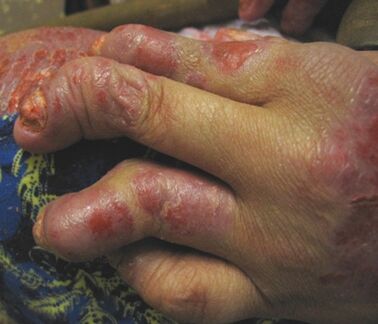According to the WHO, 2-4% of the world's population currently suffers from psoriasis. The disease affects patients of all ages, but most often young people (15-25 years). Unfortunately, medical psoriasis today cannot be completely cured, but timely professional treatment significantly improves the quality of life. Therefore, it is better to consult a doctor immediately at the first symptoms.
Psoriasis- This is a dermatosis that manifests itself in the form of scaly papules on the skin. Its distinctive feature is that in addition to the skin, it can also affect the joints and nail plates. Hereditary factors are clearly traced in the pathogenesis of psoriasis and are only secondary causes of other irritants.
During the exacerbation of the disease, the natural formation processes are disrupted - keratinocytes (cells that are mainly composed of human skin). There are also obvious biochemical changes in the skin. In addition, doctors have recently been able to detect abnormal nervous system function in the acute phase of the disease. In general, the main cause of psoriasis is a malfunction of the immune system.
The spread of psoriasis
Psoriasis is very common. Currently, the morbidity statistics are roughly as follows:
- China - 0. 3%;
- USA - 1%;
- Denmark - 1-2. 3%;
- Northern Europe - 3%;
- Germany - 1-1. 3%.
It is interesting that the indigenous population of South America is not affected by the disease. At least no such incident has been reported so far. If you look at the situation as a whole, the proportion of psoriasis is about 6-8% of all skin diseases.
As already mentioned, psoriasis manifests itself at any age, but in most cases, young people (up to 25 years) still suffer, and it occurs with equal frequency in both men and women.
Epidemiological situation
According to the causes, psoriasis is a non-communicable disease with a certain genetic predisposition. Relatives who are most at risk are also people who suffer from this disease (in this case, only the closest relatives are considered). European researchers have found that if one of the parents is ill, the probability of transmission to the child is 14-25%. If both parents are ill, the probability is already 41-60%.
Psoriasis is divided into two groups according to the type of disease:
- early;
- late.
This proves that there are two main types of psoriasis (like diabetes mellitus). The first occurs in humans at an early age (average 16-22 years), is completely hereditary in nature, and is directly related to the HLA phenotype (HLA-Cw6). The course of the disease is often severe, and over time, the disease only progresses.
Because the causes of type II psoriasis are so random, the disease is sporadic. It occurs most often in older people (about 60 years). In general, it lasts quite easily, but in some cases can be aggravated by damage to the joints and nails.
Factors that provoke the appearance of psoriasis
Although psoriasis tends to be hereditary, it is generally multifactorial. Anything can trigger a deadly problem of the immune system. Therefore, motivating factors are divided into external and internal (or exogenous and endogenous in scientific language).
Exogenous factors

They, in turn, are divided into physical and chemical. The first includes common mechanical damage to the skin, such as home injuries, thermal burns, abrasions, scars, tattoos, scratches, insects, and pet bites. Cases of psoriasis have also been reported at injection sites. X-rays and ultraviolet radiation also play an important role. In about 5% of all cases, the disease occurs in the summer, and 40% of them are caused by sunburn.
Chemical factors are expressed in the toxic effect of harmful chemicals or other irritants on the skin. In addition, psoriasis is triggered by other skin diseases, for example:
- dermatoses;
- fungal infections;
- infectious impetigo;
- acne;
- dyshidrosis;
- lichen;
- herpes zoster;
- gangrenous pyoderma;
- Allergic dermatitis of various nature.
There are cases when the disease is known after elementary diagnostic skin tests to study the body's reaction to cosmetics, hygiene products, formalin, chromium, nickel and other chemicals.
Endogenous factors
Internal causes of psoriasis can be infectious diseases. Recent research in this area shows that streptococcal infections and HIV are more likely to be to blame. In addition, the symptoms often do not appear during the disease itself, but even after the usual vaccination. In these cases, psoriasis is often difficult to treat.
Lithium, beta-blockers, non-steroidal anti-inflammatory drugs, and ACE inhibitors are used to induce remission. In this case, corticosteroids are contraindicated.
Pregnancy and childbirth
Significant changes in hormonal levels caused by pregnancy can also be a motivating factor. A similar pattern is observed during adolescence. It is also interesting that women with psoriasis may have an improvement in their condition during pregnancy (40%). Deterioration is less common (only 14% of cases). It is true that in most patients the condition worsens after birth (in 54% of cases).
Diet and nutrition
These factors often do not significantly affect the course of the disease. It is only known that alcohol and smoking significantly increase the chances of developing psoriasis and worsen its course.
Hypocalcemia and hypokalemia
These factors can trigger the appearance of generalized pustular psoriasis. In this case, the chances of getting a favorable result are very low.

Pustular psoriasis.
Psychogenic factors
Today, the roles are considered quite controversial. Some researchers claim that the presence of traumatic psychogenic factors triggers psoriasis in 60% of all cases. However, it is only known that they can worsen the course of the disease and reduce the effectiveness of therapy.
Classification
Currently, several different types of psoriasis have been identified. They differ significantly in the clinical picture and the degree of impact on the body, so it is better to look at the World Wide Web and carefully study the pictures of psoriasis to get an idea of the dangers, get acquainted with the various etiologies, as well as descriptions.
Weak psoriasis
Vulgar or common psoriasis occurs in most cases. The disease manifests itself as an abundant rash of small, bright red papules (from the head of a match to a pea). They grow quickly after emergence and appear silvery-white scales on their surfaces. In the future, the papules become plaques that merge into one large lesion. Often there are clear boundaries that separate them from healthy skin.
When you try to scan or remove a papule, the first increase is in the money. This phenomenon is known as the "stearin stain symptom" and a shiny, smooth surface, "terminal film symptom", can be found after all the scales have been removed. If you continue to scrape, the capillaries are injured and blood droplets are released. This symptom is known as "blood clot".
The development of psoriasis is divided into three main stages:
- progressive (acute);
- stationary;
- resolution period.
The success of treatment here depends largely on how well the therapy is chosen, as the effectiveness varies significantly over time.

Development period. A feature of this stage is the abundant appearance of a particular rash. During the exacerbation phase, certain parts of the patient's body are covered with small papules that are actively peeling off. In this case, the peel is definitely localized and does not affect healthy skin. Acute psoriasis is easy to identify with a characteristic red or pink border that limits the papule.
The most characteristic symptoms at this stage are itching and the presence of the so-called Koebner's symptom. Second, psoriatic papules are characterized by the appearance at the site of any skin lesion (small burns, scratches, injections, scratches, etc. ). This phenomenon occurs on average two weeks after injury and occurs in 38-76% of all patients.
It is extremely interesting to see (less) frequent side effects. Scientists believe that this is due to the presence of specific factors in the blood serum of some patients that inhibit Koebner's syndrome.
Stationary period. On average, 2-3 months after the appearance of the first rash, the formation of new papules stops. The growth of the boards also stops. At this stage, all surfaces are already covered with scales. This process can last for months or even years. But the latter is relatively rare.
Solving time. This period is also called the lag period, because during this period there is a gradual decrease in the plate. First, they stop peeling, and then they gradually smooth out until they are completely gone. If the disease is mild, this phenomenon occurs spontaneously. Treatment only accelerates the onset. Often the location of the plaques is characterized by depigmentation or slightly less hyperpigmentation in the background of healthy skin areas. Rash with psoriasis vulgaris can occur almost anywhere and is generally localized symmetrically (extensor surfaces of the elbows and knees). It can also be seen on the head, sacrum, hands, palms, bases, groin and underarms. In addition, in many cases, the nail plates are also affected (appearance of dotted holes, loosening, thickening). These symptoms are very similar to those that occur when infected with fungi, so the final diagnosis is made only after receiving a negative reaction to fungal spores in a special laboratory study. Psoriasis vulgaris has no general adverse effects on the patient's body as a whole and is chronic. Periods of exacerbation occur in autumn or winter, while exacerbations in summer, by contrast, are less common. The main stimulus for active treatment is that without appropriate therapy, psoriatic plaques can cover the body for years, and adequate treatment can lead to improvement after a few months.
Psoriatic erythroderma
Psoriatic erythroderma is one of the most unpleasant forms of this disease. On average, a similar reaction is observed in about 2% of patients, and this occurs as a result of both spontaneous and incorrectly selected treatment. Of course, the risk of psoriatic erythroderma is higher, even if the drugs used irritate the skin or expose it to ultraviolet radiation. Often, psoriatic erythroderma occurs suddenly in the early stages of psoriasis. It can be combined with arthritis and generalized pustular psoriasis, and exposure to factors such as streptococcal infections or hypocalcemia significantly increases the likelihood of such a complication. Acute withdrawal of corticosteroids can also worsen the condition. The appearance of erythroderma completely eliminates the clinical symptoms of psoriasis, instead diffuse redness of the skin, severe itching and lamellar peeling.
Pustular psoriasis
It is also a form of severe psoriasis. It is often characterized by the appearance of an abscess that remains as the only symptom. Less often they are combined with the classic symptoms of psoriasis vulgaris. Pustular psoriasis is generalized and localized. The second is that abscesses in this condition are concentrated only in the palm or sole area.
Psoriatic arthritis
Currently, psoriatic arthritis is classified as an autoimmune disease in itself. It is expressed in bone and muscle damage in patients who already suffer from psoriasis or have a high family history of the disease. Very often psoriatic arthritis is combined with classic psoriasis along with psoriasis nails. The disease is diagnosed with low back pain accompanied by the following conditions:
- lack of a clear reason for appearance;
- the patient is over 40 years old;
- unexplained deep pain in the lower back or back;
- unclear localization of pain;
- reduction of pain after exercise;
- pain or stiffness is felt early in the morning or at night;
- the presence of pain, which is a perfect general condition of the musculoskeletal system.
Psoriasis of the nail plates
Often, psoriasis vulgaris is accompanied by nail damage. In this case, the symptoms characteristic of their overt dystrophy and fungal infections are observed. It is often a companion of psoriatic arthritis. If we take into account that about 4% of the world's population suffers from common psoriasis, 30-50% of them also have nail psoriasis.
Psoriasis treatment
Unfortunately, medicine is still unable to treat psoriasis, as it requires more in-depth information about the characteristics of the basic mechanisms of the human immune system. As this type of research progresses very slowly and the disease itself does not pose a certain threat to life, symptomatic therapy is now a priority. Before starting treatment, the patient needs a thorough examination, because each organism contains a number of individual factors that affect the course of the disease. Gender, age, occupation, general health, type of psoriasis - all these should be taken into account when prescribing therapeutic therapy. The nature of the course of the disease, individual sensitivity to drugs and the establishment of the current stage of the disease also play an important role.
General activities
First of all, the doctor must determine the mental and physical condition of the patient, assess the general condition of the body and learn how resistant he is to the disease. The best conditions for effective treatment are good rest, staying in a quiet environment, switching to a less intensive work regime, or short-term hospitalization. Various psychotherapy methods (rehabilitation in seaside resorts using cognitive-behavioral therapy, etc. ) have also proven themselves very well. It is also important for the patient to know that the recovery period is going as it should, because without a rapid response, about 40% of patients lose confidence in the effectiveness of therapy and ignore it. It is important to remember that psoriasis is a chronic disease, so the safety of therapy should be considered. Many drugs are toxic and can accumulate in the body, turning into a time bomb. An addictive effect is also possible, so it is best to keep the most dangerous medications until you see really dangerous symptoms.
The course of the disease and long-term prognosis
The course of psoriasis is often unexpected. Modern doctors have practically failed to do so, so as before, psoriasis remains an unpleasant and uncontrollable disease. In each case, it continues entirely individually, as attempts to predict the course of the disease, as well as the duration of the exacerbation and remission stages, are doomed to failure in advance. Only one thing is gratifying - despite the difficulty of treatment, it rarely poses a real threat to the patient's life. As for psoriatic arthritis, this disease is easier than rheumatoid arthritis, and the reduction in patients' quality of life is insignificant compared to the latter. Statistics show that with proper treatment, the majority of psoriatic arthritis patients remain functional and can live a decent life. In the absence of appropriate therapy or if the disease continues with complications, deformities may develop with the further development of severe pathologies. However, such complications occur in very few patients with psoriasis. Most patients can count on a gradual stabilization of the condition and the appearance of long-term remissions (more than two years). In very rare cases, the disease persists mainly in the active phase, but in this case it can be effectively localized. Today, an effective treatment for psoriasis can be obtained in any major city. As you know, the final recovery can not be achieved, although diet, special medications and procedures will do the job quickly. Also, you will not need long-term treatment in a hospital. The doctor's task is only to quickly skip the first two stages of psoriasis and bring the person into remission. After that, the patient can only look after himself, follow the instructions and forget about the disease for a long time.























